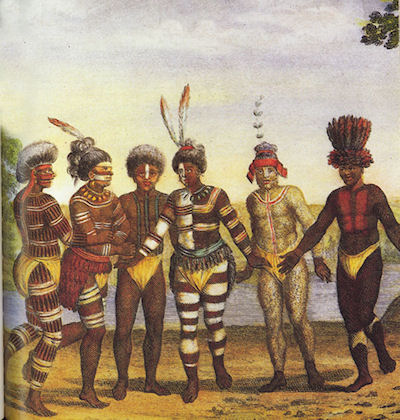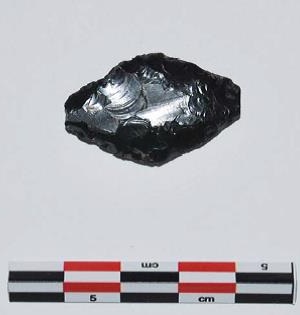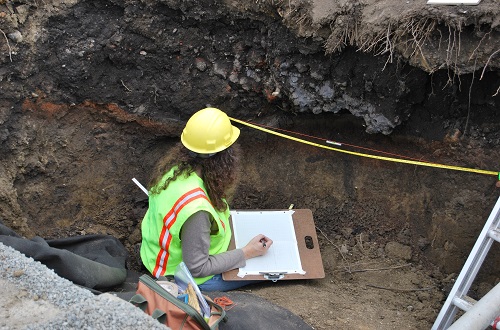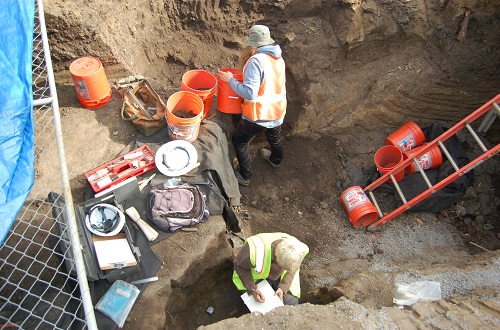Archaeological Discoveries in San Mateo
The Ohlone (pronounced: O-LO-nee) have lived throughout the San Francisco Peninsula for thousands of years. During construction of the Bay Division Pipeline Reliability Upgrade Project (project), a new 21-mile pipeline from the City of Fremont to Redwood City that included a 5-mile crossing under the Bay, several buried Native American sites were exposed. We collaborated with Ohlone representatives, San Francisco Planning Department cultural experts, and archeological consultants to share about Ohlone history, culture, and these sites.
Many Ohlone live throughout the Bay Area today. We would like to acknowledge the following people for their guidance during this project: Jakki Kehl, Mutsun Ohlone, who was assigned by the Native American Heritage Commission as the Most Likely Descendant to provide recommendations for the respectful treatment of Native American remains and artifacts; Amah Mutsun Ohlone Irene Zwierlein, Michelle Zimmer, and Garry Zimmer who monitored construction; and artist Linda Yamane, Rumsien Ohlone.

The Ohlone and other native peoples have lived in the San Francisco Bay Area for at least 10,000 years. Although modern Indian people and scholars who interviewed their ancestors have left us with a lot of important information, the only direct evidence we have of these people and their world are the things they left behind. Archaeology is all about discovering and studying these artifacts and sites.
Fragments of animal bone and pieces of shell are the remains of a meal. Flakes of stone are left over from making a spear point and beads are fallen from a broken necklace. Villages and temporary camps sometimes contain remains such as cooking hearths or the scooped-out earthen floors of houses. Archaeologists call these concentrations of artifacts and structures “archaeological sites.” Some can be found on the surface but others are buried several feet underground. These archaeological sites tell us about the lives of the Ohlone and other peoples: what they ate, where they lived, how they interacted with the natural world and with their neighbors, and how their cultures developed and changed over time. Archaeologists see these sites as non-renewable resources: once gone, they are gone forever. This is why many would rather see sites preserved than dug up–even by archaeologists.
Archaeological Sites are Protected by Law
In the 19th and early 20th centuries, many ancient archaeological sites around the San Francisco Bay were destroyed as roads, buildings, and other structures were built. The soil from these sites was sometimes used as road fill and building pads, and even as garden soil. The Emeryville Mound, for example, was said to be 60 feet high and 350 feet in diameter. Today, there’s not a sign of it on the surface.
These days, archaeological sites are protected by various laws. When the San Francisco Public Utilities Commission (PUC) planned to build and then uncovered archaeological sites during construction, the agency had to comply with both the California Environmental Quality Act and the National Historic Preservation Act that protect archaeological sites.

The Native American Heritage Commission in Sacramento is one State organization that helps protect archaeological sites. Another is the California Historical Resources Information System that keeps articles, maps, and technical reports about archaeological sites. Archaeologists and Native Americans now often monitor construction work in areas where native peoples may have lived or travelled, so that any artifacts or sites that are uncovered are treated with care.
Preserving Archaeological Sites
Because the Project team knew the pipeline was crossing areas once occupied by the Ohlone people (pronounced: O-LO-nee), we anticipated that we might encounter archaeological sites and artifacts during construction.
The types of things we expected included concentrations of shellfish remains, evidence of fire (ashes, charcoal, burnt earth, fire-cracked rocks), concentrations of bones, and artifacts like arrow points, shells beads, and stone mortars (bowls).
In order to preserve archaeological sites that might be present, the Project team worked with archaeologists and Native Americans before construction started to figure out where archaeological sites might be found along the pipeline route. The team used many methods to discover and then investigate these sites if found. We studied reports and maps about previously located archaeological sites; carefully walked the pipeline route to look for materials at the surface; consulted with Native Americans to see if they knew of any sensitive areas; and carefully dug “test units” at various locations before construction of the pipeline started.
This research told us that several sites were either in or near the pipeline work area. Knowing this, we were able to revise our project at some locations and plan to carefully dig through the other sensitive area.

Archaeological Discoveries
While replacing part of the enormous water pipeline in Redwood City, team members discovered an archaeological site. Archaeologists had known about the site since the 1950s but thought it was a few hundred feet away from the work area and had been mostly destroyed by other, previous construction in the area. Although early archaeologists had made a map of this site, it was not very accurate. It’s hard to figure out the boundaries of something that is underground! In this case, there were no artifacts on the ground surface to give a clue of the presence of the site buried underground—but during digging for the pipeline, the well-trained eyes of the project archaeologist and Ohlone Native American monitor spotted pieces of shell, dark soil, and a few flakes of chert left from making stone tools. When they were exposed, work was immediately stopped and the archaeologists and Native Americans worked together to carefully remove what was found and treat the materials with respect.

To find out about the site and record it for others to learn about before this part of it was gone, archaeologists and Ohlone people worked alongside the PUC’s pipeline crew as they continued digging the trench. They watched closely, looking for artifacts and signs of cultural remains. When the crew had dug nearly three feet below the ground the archaeologists spotted something—clay that had been baked hard and rocks that had been cracked from the heat of a fire. More soil was slowly cleared away and the small area of baked clay and rock grew larger. It was a cooking hearth!
The hearth was carefully cleaned of loose soil using small hand tools, and photographed by the archaeologists, who also drew a map to mark its location. Pieces of oyster and clam shell were found among the rocks and clay—the remains of a long-ago shellfish meal. The archaeologists also found a piece of charcoal in the hearth. They sent it to a laboratory to find out how old it was using a process called radiocarbon dating. The hearth turned out to be about 600 years old.
We now know that hundreds of years ago, in that very spot, people gathered to cook their meal around a fire. Children may have played nearby in a grove of trees or helped their parents to collect and prepare the food that they would soon eat. Archaeological studies like this one help us to piece together the story of when, where, and how the people who came before us lived their lives.
At another location, archaeologists discovered a sizeable shellmound with at least one human burial and potentially more. This presented a challenge. The pipeline had to go through but no one wanted to disturb the site. What could be done? PUC’s engineers came up with an imaginative solution: they put the pipeline in a horizontal “micro-tunnel” drilled under the site. By doing this, the archaeological site was fully protected and preserved in place.
An Ohlone View
To many Ohlone people, these archaeological sites have special importance far beyond the scientific information they provide. For them, these sites provide a connection with their ancestors who lived, laughed, and raised their children here. While Ohlone often work alongside archaeologists to care for sites that are found, many would rather see these places preserved than scientifically excavated or destroyed.

